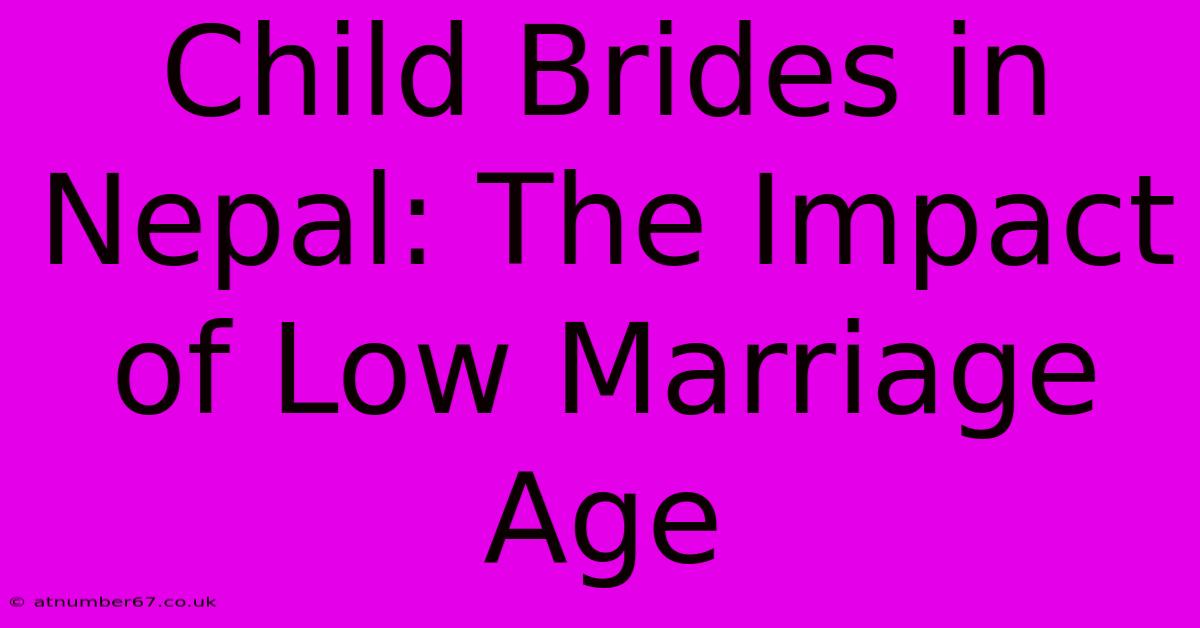Child Brides In Nepal: The Impact Of Low Marriage Age

Table of Contents
Child Brides in Nepal: The Impact of Low Marriage Age
Child marriage remains a pervasive issue in Nepal, despite legal prohibitions and ongoing efforts to eradicate the practice. The devastating impact of marrying young girls extends far beyond the immediate consequences, shaping their lives and futures in profound ways. Understanding the far-reaching effects of a low marriage age is crucial to tackling this complex problem.
The Harsh Realities of Child Marriage in Nepal
Nepal has made significant strides in reducing child marriage rates, but the challenge persists, particularly in rural areas and marginalized communities. The practice is often rooted in deeply ingrained cultural traditions, poverty, and a lack of education. Families may view marrying off their daughters young as a way to secure their economic future, reduce the burden of their upkeep, or protect their perceived honor. However, these justifications mask the devastating consequences faced by child brides.
Immediate Impacts: Health and Education
The most immediate and visible impacts of child marriage are on the health and education of young girls. Child brides are significantly more likely to:
- Experience severe health problems: Early pregnancy and childbirth put immense strain on their still-developing bodies, leading to complications such as obstetric fistula, anemia, and even death. Their lack of access to proper prenatal care exacerbates these risks.
- Drop out of school: Marriage often forces girls to abandon their education, limiting their future opportunities and perpetuating a cycle of poverty. The lack of education further restricts their ability to make informed choices about their health and well-being.
- Suffer domestic violence: Child brides are particularly vulnerable to domestic violence, abuse, and exploitation. Their lack of agency and power within the marital relationship makes them more susceptible to harm.
Long-Term Consequences: Societal and Economic Impacts
The consequences of child marriage extend far beyond the immediate health and educational impacts. They have far-reaching societal and economic ramifications:
Limited Opportunities and Empowerment
Child brides often have limited opportunities for personal growth and empowerment. Their lives are largely dictated by their husbands and in-laws, restricting their ability to pursue their aspirations and contribute fully to society. This lack of agency limits their ability to escape poverty and improve their lives.
Intergenerational Cycle of Poverty
The consequences of child marriage are often intergenerational. Girls who marry young are more likely to have children early and frequently, perpetuating a cycle of poverty and hardship for their families. This cycle limits their ability to escape poverty and provide their children with a better future.
Social Stigma and Isolation
Child brides often face social stigma and isolation within their communities. They may be ostracized and discriminated against, further limiting their opportunities and support networks.
Combating Child Marriage in Nepal: A Multifaceted Approach
Addressing child marriage in Nepal requires a multifaceted approach that tackles its root causes and provides support to vulnerable girls and their families. This includes:
- Strengthening law enforcement: Ensuring that laws prohibiting child marriage are effectively enforced and that perpetrators are held accountable.
- Improving access to education: Providing girls with access to quality education, which empowers them to make informed choices about their lives.
- Promoting awareness and changing social norms: Educating communities about the harmful effects of child marriage and challenging harmful cultural practices.
- Empowering women and girls: Providing girls and women with access to resources and support to enable them to make independent choices.
- Improving access to healthcare: Ensuring that girls and women have access to quality healthcare services, including sexual and reproductive health services.
Conclusion:
Child marriage in Nepal is a complex issue with devastating consequences. Addressing this issue requires a comprehensive and sustained effort from governments, NGOs, and communities. By investing in the education and empowerment of girls, challenging harmful cultural practices, and strengthening legal protections, Nepal can make significant progress towards eliminating child marriage and securing a brighter future for its young girls. The fight against child marriage is a fight for their rights, their health, and their future. Only through collaborative efforts can we break this cycle of poverty and suffering.

Thank you for visiting our website wich cover about Child Brides In Nepal: The Impact Of Low Marriage Age. We hope the information provided has been useful to you. Feel free to contact us if you have any questions or need further assistance. See you next time and dont miss to bookmark.
Featured Posts
-
Alysha Burneys Age The Untold Story
Mar 31, 2025
-
Understanding Elon Musks Net Worth Growth
Mar 31, 2025
-
Finding Peace In The Chaos Of Insanity
Mar 31, 2025
-
Ciara Age Her Ongoing Impact On Music And Culture
Mar 31, 2025
-
Dj Toxic Son Of Dragon Dance The Night Away
Mar 31, 2025
